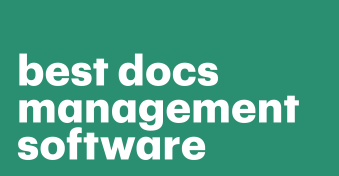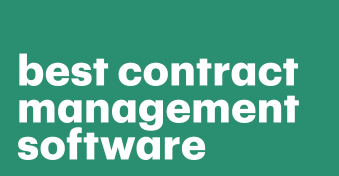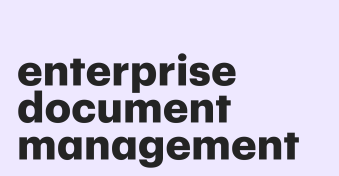Choosing the right format for your documentation helps ensure that the content is easy to access and understand.
The repercussions of not getting this right can be grave: misinterpreted content, confused employees, legal complications and much more.
In this comprehensive guide, we’ll detail a 4-step framework to get ideal documentation formats comfortably under your fingers and running at full steam.
Key takeaways
- Documentation formats define the purpose, structure and style of various documents, including standards that differentiate formatting rules according to publication requirements.
- The 4-step framework is a systematic approach to selecting and customizing content arrangements, including reviewing the format requirements, analyzing factors, choosing a template, and customizing it.
- Document management tools streamline the creation, management, and signing of documents, offering a competitive edge over manual approaches.
Understanding documentation formats
Documentation formatting is the structural guidelines to be followed during the creation of similarly-purposed documents.
The formats refer to the specific structure, layout, and design used in a document.
Formats include elements such as headers, footers, indents, bullet points, numbering, tables, and syntax, as well as more specific usage of specific abbreviations, identifiers, line spacing, or annotations.
Document structuring approaches organize information in a way that makes it easy to read, understand, and reference.
The formatting guarantees a logical progression of ideas, with distinct separations between various sections and subjects, enhancing readability and comprehension.
For example, two non-disclosure agreements for different counterparties still have the same blocks and rules for populating the doc — therefore, they have the same format.
Before we dig into our 4-step framework, let’s take a moment to clearly define a few basic terms in order to minimize any confusion.
Documentation styles
While documentation formats focus on the structural aspects of a document, documentation styles are concerned with citation and referencing conventions.
For example, the American Psychological Association’s APA style, MLA style, and Chicago style all dictate how sources should be cited within the text and in the reference list, whether to use Oxford commas or not, etc.
These requirements for documentation styles are usually reflected in style guides.
Documentation styles are often specific to academic and scholarly writing, whereas documentation formats are applicable across various types of documents, including business proposals, user manuals, and technical specifications.
Publication formats
Publication formats, on the other hand, refer to the medium in which a document is published, such as print, online, PDF, or DOC.
While documentation formats guide the arrangement of content within the document, publication formats determine how the document is accessed and consumed by the readers.
For instance, an online publication format may include interactive elements like hyperlinks, while a print format would not.
Finally, a document is a broad term that encompasses any written or printed material containing information.
A report, however, is a specific type of document that presents detailed information on a particular subject, often including research, analysis, and recommendations.
While all reports are documents, not all documents are reports.
A 4-step framework to get your ideal documentation format
Whether you’re drafting a legal contract in the banking sector or creating a user manual in the technology industry, the right presentation method is essential for clarity, efficiency, and compliance.
The 4-step framework outlined below is designed to be adaptable and applicable across various industries, including software and technology, healthcare, banking/financial services/insurance, and education.
It’s a practical tool that empowers you to master layout approaches, streamline operations, and enhance communication within your organization.
Briefly, the framework is as follows:
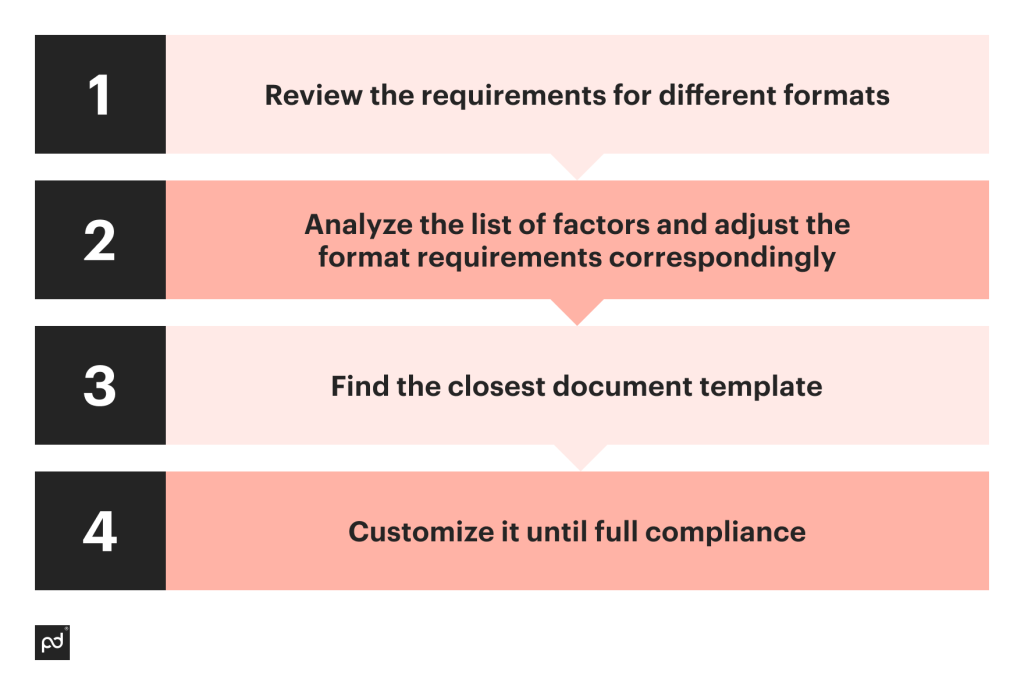
Following these four steps, you can achieve:
- Consistency across all documents, enhancing brand image and professionalism.
- An accelerated document creation process, using predefined templates and structured guidelines.
- Better communication and collaboration among stakeholders.
- Ease of reference within a document, thanks to logical organization and indexing.
- Compliance with industry standards, adhering to accepted formats.
Now, it’s time to take a closer look at the framework steps!
1. Familiarize yourself with existing doc formats
Let’s overview the most popular formats based on document purpose, and their requirements.
User manuals
Guides for end-users on how to use a product or service, including step-by-step instructions, diagrams, tutorials, and troubleshooting tips.
Choose this format if you need to provide clear guidance to customers or employees on using a specific product or tool.
Options include software guides, appliance manuals, and training guides.
Mostly applicable for: Software and technology, professional services, healthcare, education, manufacturing, consumer electronics.
Format requirements
Structure: Clear step-by-step instructions, troubleshooting section, glossary, table of contents.
Design: Sans-serif font (e.g., Arial, Calibri) for readability, neutral color with brand colors for headings and highlights, two-column layout with clear section breaks.
Visuals: Annotated screenshots, diagrams with labels.
Other: Durable paper for physical manuals, interactive index for digital versions.
Technical specifications
Detailed descriptions of technical requirements or features, often including measurements, materials, and standards.
Opt for this format to communicate technical details to engineers or manufacturers.
Options include product specifications, and engineering guidelines.
Mostly applicable for: Software and technology, manufacturing, construction, automotive, aerospace.
Format requirements
Structure: Detailed descriptions, version history.
Design: Monospace font (e.g., Courier New) for technical details, neutral color with emphasis on technical diagrams, single column layout with sidebars for notes.
Visuals: Technical drawings, schematics.
Other: QR codes linking to more detailed online resources.
Business proposals
Formal offers or plans are presented to potential clients or partners, outlining the scope, benefits, and terms of a proposed agreement.
Select this format in order to present offers like sales contracts, service contracts, and employer and worker contracts.
Mostly applicable for: Professional services, banking/financial services, insurance, real estate, retail, consulting.
Format requirements
Structure: Executive summary, terms and conditions, pricing.
Design: Serif font (e.g., Times New Roman) for formality, brand colors with a professional tone, single-column layout with clear section breaks.
Visuals: Infographics, company logos, client logos.
Other: High-quality paper for printed versions, interactive links for digital.
Project plans
Roadmaps outlining the scope, timeline, resources, and milestones for a project.
Utilize this format in cases of project coordination and tracking.
Options include development plans, marketing campaigns, and event planning.
Mostly applicable for: Software and technology, professional services, education, construction, event management.
Format requirements
Structure: Objectives, timeline, budget.
Design: Sans-serif font for clarity, neutral color with color-coded phases or milestones, tables, Gantt charts, timelines.
Visuals: Flowcharts, resource allocation graphs.
Other: Color coding for different project phases.
White papers
In-depth reports or guides on a specific topic, providing insights, analysis, and solutions.
Opt for this format to provide insights on complex subjects like industry trends, policy analysis, and technical solutions.
Mostly applicable for: Software and technology, healthcare, banking/financial services, insurance, government, research institutions.
Format requirements
Structure: Abstract, detailed analysis, conclusion.
Design: Serif font for academic tone, neutral color with occasional brand colors, two-column academic format.
Visuals: Graphs, charts, tables.
Other: Citations, bibliography.
Case studies
Detailed analyses of specific events, situations, or subjects that are often used for educational or marketing purposes.
Choose this format if you need to illustrate success stories, problem-solving, and best practices.
Mostly applicable for: Healthcare, education, marketing, nonprofit organizations, consulting.
Format requirements
Structure: Introduction, problem, solution, results.
Design: Sans-serif font for readability, brand colors with a storytelling vibe, single column layout with sidebars for testimonials.
Visuals: Before-after shots, client logos.
Other: testimonials, quotes.
API documentation
Guidelines for developers on how to interact with an application’s programming interface, including code examples and technical specifications.
Utilize this format for software integration, code examples, and technical specifications.
Mostly applicable for: Software and technology, e-commerce, telecommunications, automotive.
Format requirements
Structure: Endpoint descriptions, error codes.
Design: Monospace font for code, sans-serif font for text, neutral color with color-coded code snippets, single column layout with collapsible sections.
Visuals: Flow diagrams, endpoint illustrations.
Other: Interactive API playground, collapsible sections.
SOPs (Standard operating procedures)
Step-by-step instructions for routine operations, ensuring consistency and compliance.
Select this format to standardize processes like safety protocols, quality control, and HR procedures.
Mostly applicable for: Healthcare, manufacturing, food industry, logistics, government.
Format requirements
Structure: Purpose, procedure steps, review schedule.
Design: Sans-serif font for clarity, neutral color with color-coded safety alerts, step-by-step format with checklists.
Visuals: Process diagrams, safety icons.
Other: Safety icons, color-coded sections.
Product catalogs
Comprehensive listings of products, including descriptions, specifications, and pricing.
Choose this format to showcase products like electronics, clothing, and equipment.
Mostly applicable for: Retail, wholesale, automotive, consumer goods, e-commerce.
Format requirements
Structure: Product descriptions, pricing.
Design: Sans-serif font for product names, serif for descriptions. Vibrant product images with neutral text. Grid layout for products, product categories.
Visuals: High-resolution product shots.
Other: QR codes for online purchase, discount stickers.
Legal documents
Contracts, agreements, and other legally binding documents, outlining the rights and obligations of parties.
Choose this format if you need to formalize a business relationship or transaction.
Mostly applicable for: Banking/financial services, insurance, real estate, legal services, government, corporations.
Format requirements
Structure: Terms, rights, signatures.
Design: Serif font for formality. Strictly neutral color. Single column with clear section breaks.
Visuals: Company seals and signatures.
Other: Watermarked paper, digital signature capabilities.
Internal memos
Brief communications within an organization that convey important updates or directives.
Choose this format if you need to quickly disseminate to employees any information like updates, directives, or announcements.
Mostly applicable for: All industries.
Format requirements
Structure: To/from, subject, body.
Design: Sans-serif font for clarity. Neutral with brand colors for headings. Letter format.
Visuals: Company logo.
Other: Confidentiality footers.
Financial statements
Summaries of financial activities, including balance sheets, income statements, and cash flow statements.
Select this format for reporting financial performance, compliance, and audits.
Mostly applicable for: Banking/financial services, insurance, corporate, government, non-profit organizations.
Format requirements
Structure: Balance sheets, income statements.
Design: Serif font for formality. Neutral with color-coded profit/loss indicators. Tabular layout with clear headers.
Visuals: Pie charts, bar graphs.
Other: Footnotes, auditor’s seal.
Marketing materials
Brochures, flyers, press releases, and other promotional documents, designed to attract and engage potential customers.
Choose this format for advertising products, events, and initiatives.
Mostly applicable for: Software and technology, professional services, healthcare, banking/financial services, insurance, education, retail, entertainment, hospitality, tourism, media.
Format requirements
Structure: Product features, call to action.
Design: Mix of serif and sans-serif fonts for dynamic appeal. Brand colors, vibrant imagery. Brochure-style, multi-fold layout.
Visuals: Product shots, event photos.
Other: QR codes for promotions, glossy finish for print.
Educational materials
Textbooks, lesson plans, study guides, and other instructional documents, tailored to specific learning objectives.
Choose this format if you need to educate or train individuals on a particular subject or skill.
Mostly applicable for: Education, corporate training, healthcare, nonprofit organizations.
Format requirements
Structure: Learning objectives, exercises.
Design: Sans-serif font for readability. Neutral with color-coded sections. Two-column layout with side notes.
Visuals: Educational diagrams, illustrations.
Other: Interactive quizzes for digital versions, durable bind for physical.
Research papers
Scholarly articles presenting original research findings, often published in academic journals. Utilize this format for academic discourse and scientific validation.
Mostly applicable for: Education, research institutions, healthcare, environmental organizations.
Format requirements
Structure: Methodology, results, discussion.
Design: Serif font for academic tone. Neutral with color-coded graphs. Two-column academic format.
Visuals: Graphs, tables.
Other: Citations, peer-review indicators.
Meeting minutes
Written records of the proceedings and decisions of a meeting that serve as an official reference for attendees and stakeholders.
Select this format to document decisions, actions, and discussions.
Mostly applicable for: All industries.
Format requirements
Structure: Attendees, agenda, decisions.
Design: Sans-serif font for clarity. Neutral with brand colors for headings. Single column layout with bullet points.
Visuals: Company logo.
Other: Digital timestamps, action item highlights.
2. Determine requirements that will inform your documentation format choice
The goal for the next step is to analyze the context in which your document will emerge and come up with a unique set of requirements that will shape the ultimate format.
Audience
Consider the needs and familiarity of the audience with the subject matter.
Tailor the format to the reader’s level of expertise:
- Technical audiences may require specialized language, diagrams, and technical specifications.
- General audiences prefer simpler language, clear explanations, and ordinary visual aids like using italics where needed, or requirement for asterisks.
- Executive audiences often seek summarized information, key insights, and actionable recommendations.
- Consumer audiences may appreciate engaging narratives, testimonials, and visually appealing layouts.
Course, discipline, industry, or legal requirements and standards
Compliance with specific guidelines or regulations can dictate the format:
- Legal contracts must adhere to specific formatting rules, including font size, margins, parentheses types, and page numbering.
- Academic papers often follow specific citation styles like APA, MLA, or Chicago.
- Medical documentation, based on geography, may require adherence to HIPAA regulations and specific medical terminology.
- Technical manuals and tutorials may need to follow industry standards for technical specifications and safety warnings.
- Additionally, conduct research if the geography, industry, and other factors impose any other specific requirements. For example, GDPR is applicable within any industry working with the personal data of Europeans.
Distribution methods
The way the document will be distributed (printed, emailed, online) may influence the design and layout:
- Online distribution may need special markup, responsive design, hyperlinks, in-line formatting, and interactive elements.
- Printed distribution requires high-resolution images, appropriate page sizes, and print-friendly layouts.
- Email distribution may benefit from lightweight formats, embedded images, specific subject line, and mobile-friendly design.
Need for frequent updates
If the document needs regular updates, choose an option that is easily editable:
- Frequent updates required, then choose easily editable publishing formats.
- Occasional updates may be handled using PDF or static HTML, with occasional revisions as needed.
Collaboration needs
Choose publishing formats that facilitate collaboration if multiple people will be working on the document.
- Real-time collaboration requires Cloud-based publishing formats like Google Docs or collaborative platforms like SharePoint.
- Individually-contributed documents with tracking can be implemented in Word or use version control systems for sequential collaboration.
Accessibility
Ensure that the chosen format is accessible to all potential readers, including those with disabilities.
This might include considerations for screen readers or alternative text for images, influencing the choice of file type and design elements:
- Screen reader accessibility aims at using text-based formats with alternative text for images.
- Language accessibility requires translation-friendly formats and clear, universal design principles.
Software compatibility and output formats
Consider what software will be used to create the document and what file types are needed by the end users.
Compatibility with existing operating systems, tools, markup language, and user needs can guide the choice of file formats and software platforms:
- Open Source software users need ODT, ODS, ODP formats.
- Cross-platform compatibility is better with PDF or HTML for consistent viewing across different devices and platforms.
Security and privacy concerns
Depending on the sensitivity of the information, you may need to consider different security measures:
- Encryption needs — choose formats that support robust encryption like PAM if handling sensitive data, support specific file names.
- Access controls require formats that allow for detailed access permissions to control who can view or edit the document.
Budget constraints
The cost of producing the document, including design, printing, or software licensing, might influence the choice of format:
- Design costs may contain costs for templates or standardized formats to reduce design expenses.
- Printing costs — consider digital formats or bulk printing options to minimize printing costs.
- Software licensing — choose formats compatible with existing or free software to avoid additional licensing fees.
Integration with existing systems
If the document needs to be integrated with existing databases, CRM systems, or other software, the format may need to be compatible with those systems:
- Database integration — choose formats that can be easily imported or exported from your existing databases, can hold specific metadata,
- CRM compatibility — select formats that work seamlessly with your CRM system, such as Salesforce, HubSpot, or Pipedrive.
- Collaboration tools — opt for formats that support real-time collaboration and integration with tools like Microsoft Teams or Slack.
After carefully defining the purpose and analyzing the various factors that influence its design, the next steps are to choose the most corresponding template and fine-tune it to meet the specific requirements.
3. Choose a template
To select the right template, you must first find and access a corresponding catalog with a wide enough variety of templates.
With a collection of 1,000+ customizable templates, PandaDoc allows you to find templates that are closely aligned with the requirements you’ve identified.
For example, the collection currently contains 270 different agreement templates — virtually for each and every possible use case.
A note on choosing: It’s ok to take your time! With such a variety, you may come across neighboring templates that fit sufficiently yet are not as optimal as others, resulting in extra effort required for fine-tuning.
4. Fine-tune the selected template
Once you’ve chosen the template, the final step is to customize it until it fully complies with the requirements you’ve clarified in Step 2.
For document creation and modification, PandaDoc has its advanced Editor 2.0.
This drag-and-drop visual editor has a pretty simple UI, so you can fully master it in half an hour.
First, open the template you’ve selected and make a copy.
For this purpose, click on vertical ellipses on the right and then click on Duplicate.
Now, you are free to edit your template just by clicking on the elements you want to modify.
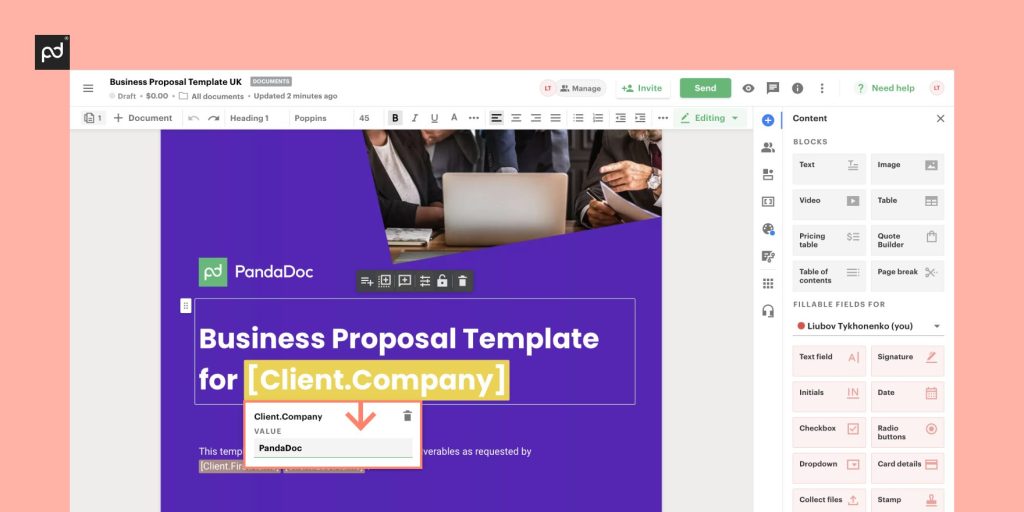
Click on a text field and change the text by typing, pasting, or populating it with variables.
In the field that you want to populate, type a left square bracket, then find and click the placeholder you’re looking for.
Adjusting the layout, incorporating brand elements, or modifying content sections are also easy.
Click on the element you want to adjust and then choose the Properties button.
Here you can change the background color, set margins or paddings, protect the block from further edits, duplicate, and delete the block.
Adding roles to your template means assigning special placeholders and defining roles who will be able to edit them.
Click Manage /+Add roles at the top, then type the role name, and click Add.
Remember, the goal is to create a document that not only looks professional but also serves its intended purpose effectively.
For adding a specific recipient who will receive all the documents created from this template, click Manage and then click the required role.
Next, choose the recipient from the list or add a new one using Pre-assign a person.
You can also set up an online collaboration and grant your teammates rules to edit your template or document.
All the edits are always saved in a version control system, so you can easily restore an older template version in case you made a mistake with what you’re working on currently.
Other editing options include table of contents customization, designing new and modifying existing pricing tables, and predefining an approval workflow.
You can find more details here, here, and here on how to create and send documents using PandaDoc Editor 2.0.
Implementing doc formats in various industries
The industry-specific stories below show how documentation formats are not just a matter of convenience or standardization.
Quite often, they form the compulsory nature of recommendations behind formatting.
Software and technology
What makes software and technology unique in terms of documentation formats is the need for facilitating collaboration among developers and precise communication between humans and machines.
In the United States, these needs are supported by the Digital Millennium Copyright Act (DMCA) which safeguards software copyrights, and the Federal Information Security Modernization Act (FISMA) which further delineates requirements for federal information systems.
On the other side of the Atlantic, the EU’s General Data Protection Regulation (GDPR) mandates stringent data protection measures, especially for software handling EU citizens’ data.
The NIS Directive is aimed at cybersecurity legislation, and the European Union Copyright Directive (EUCD) plus national copyright laws shape the documents related to intellectual rights.
And here’s how to handle the above-mentioned technical and structural complexity.
API documentation is usually has quite a specific syntax, written in Swagger, XML, JSON, or LaTeX when they contain complex math; a lightweight Markdown language for writing technical documentation; HTML for web pages; and UML is a de-facto standard approach to various diagrams.
Professional services
This term encompasses a vast array of sectors from legal to marketing, which commonly rely on expertise.
Here, documentation formats both ensure clarity and uphold existing professional standards.
In the US, the Sarbanes-Oxley Act (SOX) and the Fair Labor Standards Act (FLSA) form the usage of formats to enhance financial transparency and set employment standards correspondingly.
The EU’s Services Directive regulates the services market, and the Professional Qualifications Directive ensures that qualifications are recognized across member states.
Practically, businesses use PowerPoint, Keynote, or Google Slides for client pitches; Excel, Google Sheets, or Airtable for spreadsheets; Outlook, Gmail, Mailchimp, and other email formats for communicating with clients; contract management systems for drafting agreements; proprietary Asana, Trello, or Basecamp formats for project management documents.
Healthcare
Nowhere is the precision of documentation more critical than in healthcare, where clear communication and accurate record-keeping can mean the difference between life and death.
Formats in this sector keep the data consistent and confidential, and also set standards for medical procedures.
Digital prescriptions, for instance, have revolutionized patient care, ensuring accuracy and speed.
In the European Union, the GDPR has provisions specific to managing private patient data.
The Medical Device Regulation (MDR) governs clinical evidence documentation for the EU market.
For the United States, the Health Insurance Portability and Accountability Act (HIPAA) mandates formats for protected health information, while some Food and Drug Administration (FDA) regulations shape documentation for medical devices and pharmaceuticals.
Healthcare has a bunch of specific formats seen nowhere else like Epic, Cerner, and Allscripts for EHRs; DICOM for special images of CT scans, MRIs, and USRs; CMS 1500 and UB-04 for billing; and ePrescribing for electronic prescriptions for medications.
Banking, financial services, and insurance
These three sectors, though distinct, are bound by their focus on financial security and risk management.
Account statements, loan agreements, and insurance policies are just a few examples of the myriad of sensitive documents from these sectors.
The Dodd-Frank Act protects financial statements, disclosures, and similar documents issued in the USA from systemic risks.
American standards for data privacy explanations in account statements and loan agreements are defined by the Gramm-Leach-Bliley Act (GLBA).
European regulations include MiFID II for extensive documentation of investment services and securities transactions, as well as Solvency II standards for policy documents and regulatory filings for insurers.
Delving deeper, SEC-filed financial statements formatted as 10-K and 10-Q; banks use SWIFT for transferring wire instructions; XBRL is applied for regulatory filings and business reporting; and for data analytics and reporting, the most typical are Tableau, Power BI, or Excel.
Education
Unlike industries driven by profit or innovation, education’s core is knowledge dissemination, where fair and consistent measure of student learning is at the core.
At the same time, education most often covers minors, whose privacy is another important factor contributing to the formats of documents used here.
The United States relies upon the Family Educational Rights and Privacy Act (FERPA) over possible breaches of student records.
Additionally, the Higher Education Act (HEA) oversees the fair and transparent administration of federal student aid.
Across the pond, some provisions of GDPR are pertinent to educational institutions, making them accountable for proper student data handling.
The Bologna Process, meanwhile, is standardizing academic qualifications and their widespread recognition.
Academic papers are harmonized by consistent documentation styles, like APA or MLA.
Other education formatting practices include the usage of LMS for course content; unique formats for massive open online courses (MOOCs); LaTeX for academic papers in STEM fields; screen capturing for educational videos; and specific database formats like JSTOR for academic journal articles.
Conclusion
Mastering document formatting is more about aligning your business operations with efficiency, professionalism, and industry standards.
From understanding the nuances of various structuring approaches to implementing them across diverse industries, this guide has provided a comprehensive roadmap.
We’ve explored a 4-step framework that helps you find the format closest to your case, analyze factors, choose the right blueprint, and customize it to full compliance.
The right layout type ensures that your content is presented in a logical flow, tailored to your audience’s needs, and in step with legal requirements.
Document management software can further streamline this process.
Choose the right tool and take things step-by-step to show that your business is the right fit for the job.
Start your selection from PandaDoc.
You can try out all the features you need, like real-time collaboration, e-signature solutions, and seamless contract management, right now and for free.
Just start a 14-day trial or request a demo!
Disclaimer
PandaDoc is not a law firm, or a substitute for an attorney or law firm. This page is not intended to and does not provide legal advice. Should you have legal questions on the validity of e-signatures or digital signatures and the enforceability thereof, please consult with an attorney or law firm. Use of PandaDocs services are governed by our Terms of Use and Privacy Policy.
